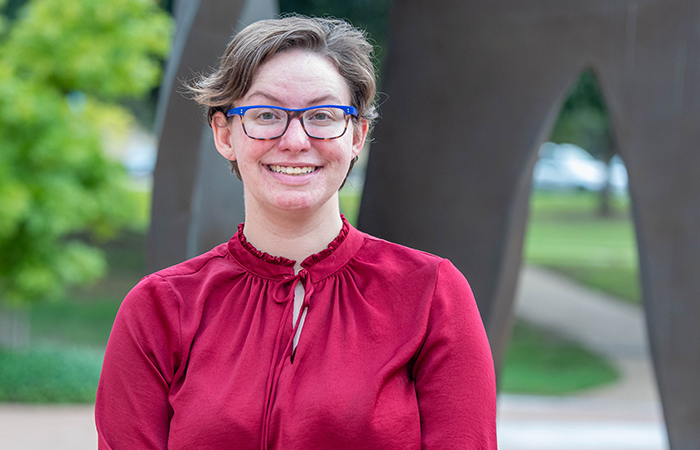Supporting her comrades in arms
Texas A&M School of Public Health Student Lyssa Losa ’21 ’25 conducts research to support military personnel health
As an Army Reservist since 2019, Lyssa Losa ’21 ’25 has first-hand knowledge of soldiers’ commitment to not only their assignment, but also to each other. Now, as a graduate student in the Master of Public Health program at the Texas A&M University School of Public Health, she focuses on research on the military environment and occupational exposure to find ways to support active and reserve military personnel and veterans who are exposed to toxic materials in their work.
“The health of the people I served with has been on the top of my mind, so I try to follow up with them pretty regularly,” Losa said. “They are all between the ages of 20 and 40, and it’s crazy that we’re going through all of these different health issues after just one deployment.”
In reserves
Because her parents were in the U.S. Army, Losa felt an affinity for Texas A&M and its military history. With an Army ROTC scholarship, the New York native enrolled as an engineering major, but found that it wasn’t a good match.
Losa took a semester break during her sophomore year to decide on her future direction and enlisted in the U.S. Army Reserves. She attended basic combat training at Fort Jackson and advanced individual training at Fort Lee before being assigned to a unit at Fort Cavazos (formerly Fort Hood).
Her unit was deployed to Iraq for nine months starting in 2021, where Losa worked as an aircraft refueler and was assigned to a mortuary affairs detail for aviation accidents and suicides. She also served as environmental safety and health lead for her site—and continues to attend training and provide aid as needed, such as helping with the Colorado wildfires in 2020.
A happy accident
Upon returning to Texas A&M in 2019, Losa experienced a series of “fun accidents” that led her to public health. She enrolled in the College of Architecture, but a technical glitch resulted in all her classes being dropped, causing her to scramble to get the courses she needed.
“All of the classes that I had been in ended up filled, so I decided to just sign up for courses that would count for something,” she said.
She enrolled in Urban Planning 371, which focused on urban policy and planning and was taught by Garett Sansom, PhD, an assistant professor at the School of Public Health.
“It was a public health class in disguise,” Losa said. “Everything just clicked—and I knew that this was what I had wanted to do forever that I could not previously put words to.”
That class reignited her original passion of studying the intersection of health and environmental safety.
“For me, it was this idea of actually taking into account how we interact not only with the natural environment, but with the built environment,” she said. “I’m really interested in the connection between anthropogenic hazards and the natural environment, and how that impacts human health. It was an a-ha moment.”
That course helped determine the rest of her undergraduate studies. “After I met Dr. Sansom, I said, ‘This public health thing is kind of cool! What public health minor can I do?’” she said, adding that she went on to earn a minor in occupational safety and health along with her bachelor’s degree in university studies architecture and minor in art and architecture history.
Reconsidering the built environment
That first course led Losa to consider different ways to look at built environments, such as the use of green spaces to serve as a buffer between communities and industry. Losa went on to assist Sansom with research funded by an Environmental Protection Agency grant that focused on the environmental justice community of Galena Park, Texas. The town, which is home to numerous industries, was the site of the 2019 ITC petrochemical fire, which released toxic chemicals into the air for four days.
As part of their research, the team surveyed community members about their interest in participating in a potential property buyout that would convert the land into a green space that could substantially reduce their risks of exposure to industrial hazards while also encouraging healthy behaviors, such as exercise. Approximately 50 percent of the affected residents surveyed said they would be interested in the buyout, and Losa shared these findings at a research event sponsored by Texas A&M University’s Don and Ellie Knauss Veteran Resource and Support Center.
Serving her comrades in arms
Losa now assists Sansom with research looking at the neurocognitive impacts caused by Camp Lejeune’s well water. Previous testing on the camp’s well water from the 1950s to 1980s found contamination from uncontrolled releases of toxins that increased the number of cases of cancer and infant mortality on the base. She is involved in the study’s design and considering whether other factors, such as jet fuel exposure, a traumatic brain injury, or being deployed near a burn pit might also be associated with these neurocognitive issues.
Even though she’s in the first semester of her master’s degree program, Losa already is contemplating a doctorate so she can continue researching these types of military matters.
“We’re all struggling with mental and physical effects after one deployment. Because we weren’t in an active-duty unit, there is very little in terms of research and a support system for us,” Losa said. “That is what is really driving me. Sooner rather than later, this type of research needs to be completed and used to advocate for improved and expanded health care for veterans.”
